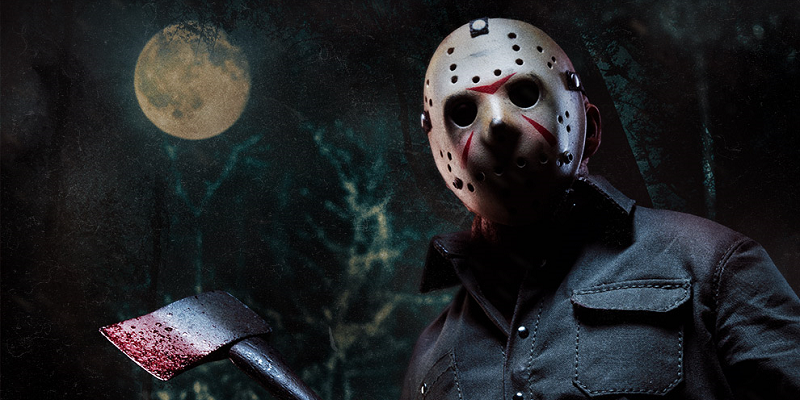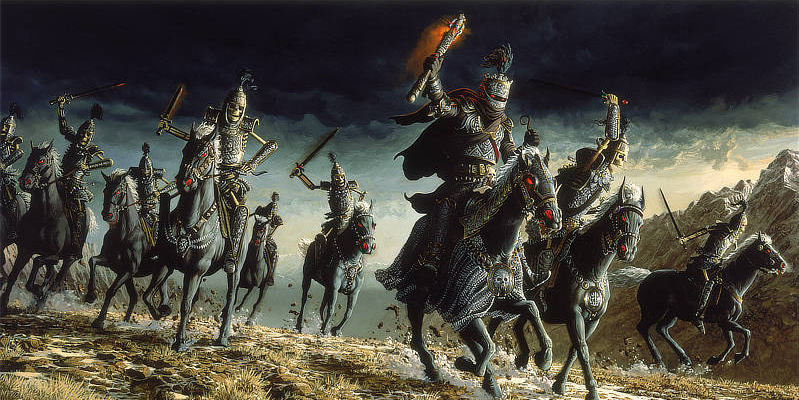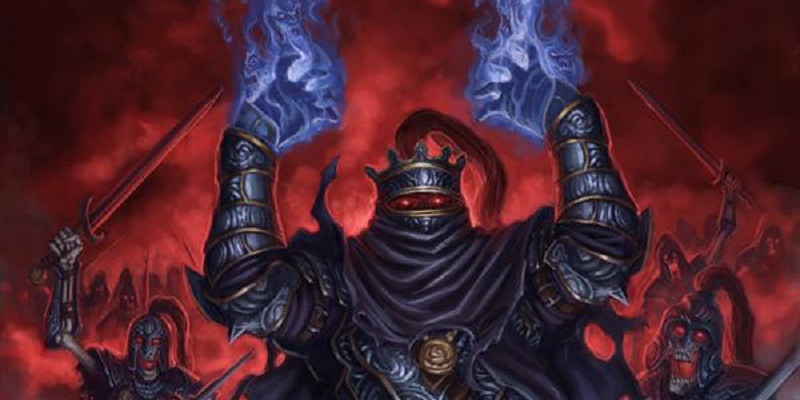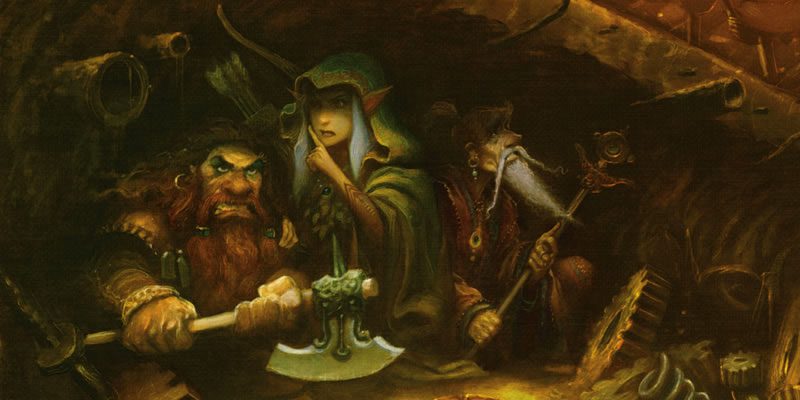Get to Know the Death Knight

It wouldn’t be Halloween without a good slasher film or show. The slasher genre is one of my favorites, as it deals with a single threat (usually), a well-defined location (ideally), and the mythos is surface-level enough to give you the deets without getting bogged down (until the sequels). It also lends itself to genre deconstruction in a way that can nail the deconstruction while staying firmly within the genre, something not exactly easy to do (Scream is a goddamn masterpiece in this regard, and the TV series of the same name is actually pretty phenomenal. Yeah, both seasons).
However, the slasher genre is incredibly hard to capture in just about any other medium. Books and audio productions can do a pretty good job, but part of the slasher experience is the visceral nature of the presentation. By necessity, this means that examples of good, interactive slasher fare are basically nil. Participation in all but the most extreme of scenarios dulls that visceral impact. Knowing you are safe and secure creates distance. This might be because the live-action immersive experience still hinges on a set of guidelines, waivers, and all sorts of other legal precautions. It might also be a result of knowing your group of adventurers has nothing to fear from a single maniac coming at them with a machete, even if they are the love-child of Medusa and Dracula, or whatever. Thinking on this, I realized that D&D does have a pretty good example of a slasher villain: Lord Soth. In fact, death knights are a pretty good template for a slasher.
Azer | Kenku | Giants | Scarecrow | Erinyes | Crossroads | Death Knight
Let me start by saying that while I am an enthusiast of both the slasher film and Lord Soth, I am not an Oxford scholar on the subjects. I can absolutely guarantee I have not seen every slasher film, nor have I read everything about Lord Soth (your Tasslehoff/Soth fan-fiction least of all, sorry). Despite that, I feel I know more than a little about both topics (Lord Soth and slashers, not the fan-fiction). Before getting into the specifics of Lord Soth, we need to take a look at the checkered past of the death knight in D&D.

The death knight first makes its appearance back in AD&D 1st edition, having been printed in 1981’s Fiend Folio. The death knight was created by Charles Stross, as part of his contributions to White Dwarf magazine. As an aside, he also created the githyanki, githzerai, and slaad, so I owe this dude a lot. At their inception, they were chaotic evil, very rare, and were solo-appearing creatures. There were also only supposed to be twelve of them to exist. The death knight was a lich-variant, created by a demon prince (probably Demogorgon) from a paladin who betrayed his or her oaths.
You can’t turn a death knight, use dispel evil, or reliably throw spells at a death knight. 75% magic resistance and an 11% chance to reflect the spell is brutal. As you might expect, the death knight has power over the undead similar to a 6th-level cleric. As you probably don’t expect, unless you already know this, death knights wear light armor. This armor always gives the death knight incredible AC, which is interesting to me. There is also some rigamarole about the death knight having an 80% chance to have a magic sword, which isn’t that interesting. If there are only twelve of them, and they are tremendous fonts of terrestrial and magical power, why not go all out and give them the full deal of weapons and armor that carry the weight of their deeds? Well, probably because it’s early design and it’s not about that. Imposing today’s sensibilities on the past is a slippery slope.
The death knight also summons a nightmare as a trusty steed, instead of the typical paladin’s horse. However, a nightmare may only be summoned into service every ten years. I assume this means the death knight summons it, and it sticks around for ten years, not that he can summon it one time in ten years, but it’s not an argument I’d place a lot of money on. Early editions, bruh. We also see the typical death knight powers we all know and love (or at least have a casual relationship with) stem from this original entry. The constant fear, seeing invisible things, detecting magic, walls of ice, massive fireballs, symbols, and power words. Oh, and it can gate in demons and shit.

As you can see, the death knight is really built from the start to be a one-person wrecking crew. Weapons and spells hardly slow one down, and the combination of spells and weapons are enough to not make anyone feel safe. The idea of the implacable killer that marches endlessly forward to reach you a slasher staple. The menace of Jason Vorhees comes from this very thing. He’s a goddamn force of nature. He looms larger than life, he never seems to hurry, instead capitalizing on the fear he generates and the mistakes of others, and he is never truly slowed down. This base concept was used to tremendous effect with the introduction of Lord Soth in the Dragonlance setting.
Lord Soth was not the first named death knight by any stretch. That honor falls to Saint Kargoth, from the Greyhawk setting, having first appeared in 1983. He’s known as the Betrayer and King of the Death Knights, and his symbol is a glowing green skull. He’s pretty metal, standing seven feet tall with glowing green skeletal features stemming from demonic plastic surgery. He has a chariot of six nightmares (I guess he waited 60 years, or Demogorgon just bought his little boy a bunch of horses out of love), and has a castle within the Gaping Maw, with direct access to his liege. His story is one of jealousy over being passed over for a promotion, eventually ending in accepting power from a demon prince. That old chestnut. He was then granted thirteen death knight followers, all of whom were fellow Knight Protectors. This, of course, belies the “only twelve” part of the original entry. Really, though, there is no reasonable expectation that keeps that part of the entry intact. Death knights are rad, and people want to feature rad things. It’s human nature.
The death knight’s popularity peaks in 2nd edition. Lord Soth, arguably the most famous death knight in D&D, is to thank for that. The death knight shows up in 1990’s Monstrous Compendium Dragonlance Appendix, and is subsequently reprinted in the 1993 Monstrous Manual. The Tales of the Lance boxed set expands a lot on the death knights of Krynn, and provides additional lore and stats for them. Weird enough, in 3e and 3.5e, it’s NOT WotC who first publishes the death knight. Necromancer Games beats them to the bunch with Tome of Horrors. WotC releases the death knight in Dragon #290 in late 2001, #291 in early 2002, and then releases it officially as part of the Monster Manual II in 2003. The update of the Dragonlance setting in 2003 saw another update to the death knight, as did a weird article on the ecology of death knights in Dragon #360 in 2007. In 4e, death knight got a major overhaul, as did most things in 4e, and it got a bunch of weird subsets I am not really keen on discussing. There is probably some value of it, but because of the earlier published novels, it’s just really #notmydeathknight.

This brings us to Lord Soth. He first pops up two years after Saint Kargoth, appearing in Dragons of Spring Dawning. Soth was a Knight of Solamnia, a chivalric order of Krynn, and had attained the highest order of knighthood within the order, Knight of the Rose. He retains much of this knightly pride, and tends to observe rules of engagement when participating in combat. His story is a pretty twisted tale of lust, adultery, murder, jealousy, and shirking of duty. As is the wont of a shared world with an impetus to release content, it became more convoluted over time. Soth’s first wife went to a witch and gave birth to a cursed abomination. He accidentally became a lich. You know, stuff like that. I am breezing past his history here, because I assume most readers are versed in Dragonlance and Ravenloft to have at least a passing familiarity with Soth. If you do NOT, I am happy to discuss it more in the comments.
The use of Lord Soth is fantastic from a tension perspective, and that is really what horror films are all about. The tension needs to increase at a rate appropriate to the story being told. This is why jump scares can suck the life out of a horror movie. This release ratchets down the overall tension and causes the action to have less of an impact. This is not universally the case, but there is a reason why the cat running across the abandoned warehouse is so derided. Think about it, how many times have heard people recall jump scare moments as their favorite moments in horror movies? Not many, I’d bet. If the film is just jump scares, it doesn’t stick in the public consciousness in any meaningful way. When it comes to slashers people tend to recall two things: chase scenes and kill scenes. These tend to be about the release of tension in conclusive ways. A kill scene is final for the obvious reasons, while the chase scene is about the safety the characters can experience post-chase. The chase scene sometimes doubles as an expository statement about space-definition, but that depends entirely on scene placement.
If you think about Lord Soth for a moment, his actions really nail this. I wouldn’t even say the scenes of character building or exposition that involve him are really outside the confines of the slasher framework. A big part of why slashers work is that you get to read into the words and actions of the characters, when the villain isn’t a monster, of course. Lord Soth is written with his endgame in mind, lending great weight to all of his words and actions over the course of his appearances. This is actually more true in Dragonlance Legends than his initial appearance, which largely serves as a parallel of his own tragic tale. Even this isn’t necessarily weird with slashers, as the sequels are sometimes better than the originals. Shit, we didn’t even get Jason until a sequel, after all.

One of the greatest things about Lord Soth was than any time he showed up, you knew someone might die. At any moment he might break out power word: kill and that would be it for your favorite character. If that huge barrier was overcome, you still had to contend with his incredible sword skills and the other magic at his disposal. The best example of this is during the Blue Lady’s War. There are events occurring in the Tower of High Sorcery in Palanthas, and Lord Soth is seeking to breach the unconquerable city of Palanthas. He utilizes his powers to inexorably march through the city, killing all in his path as he marches towards the tower. His focus here is single-minded: get to the tower and Kitiara. The protagonists have to complete their task before Soth reaches the tower, or it’s game over.
You could pretty much replace Soth with Jason in this segment and have it read the same. They are forces of nature with singular intent. Of course, we get spoiled here and have the character arcs and reveals that are more closely associated with the mystery-killer slasher approach. When Soth’s final goal is revealed, it’s very similar to the de-masking that occurs in the climax of a slasher. Man, now I am thinking of Soth running around in a space barge in Spelljammer. He just wants his sword back…
5e actually diminishes the potency of the death knight a bit, though hellfire orb is nothing to sneeze at. The lack of an instant death mechanic alleviates some of the previous terrifying guarantee of death, but instant death is frustrating for a number of reasons during a session. The death knight can easily still work, of course. It’s pretty burly, and the same implacability can easily be imposed. The Sothian twist of honor was a good one, too. I wouldn’t necessarily reuse it if I was running a death knight as a slasher villain, because it’s been done, but it would have me considering what else I could do it.
I hope this was enlightening in one way or another. I love death knights, Lord Soth, and slashers. It seemed like a natural intersection of ideas, to me. Having the deathly knight stalking characters seems terrifying in the best ways.



